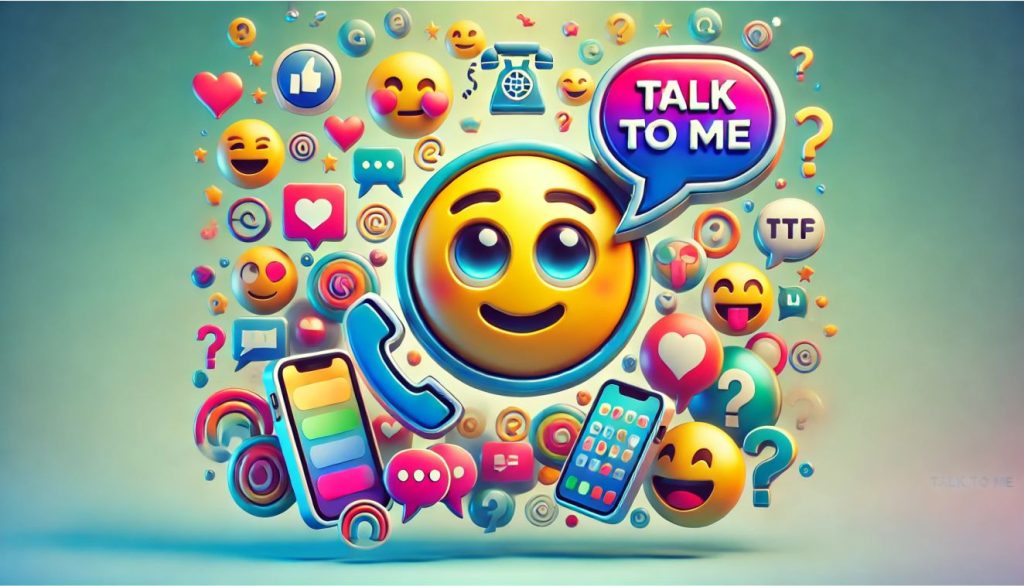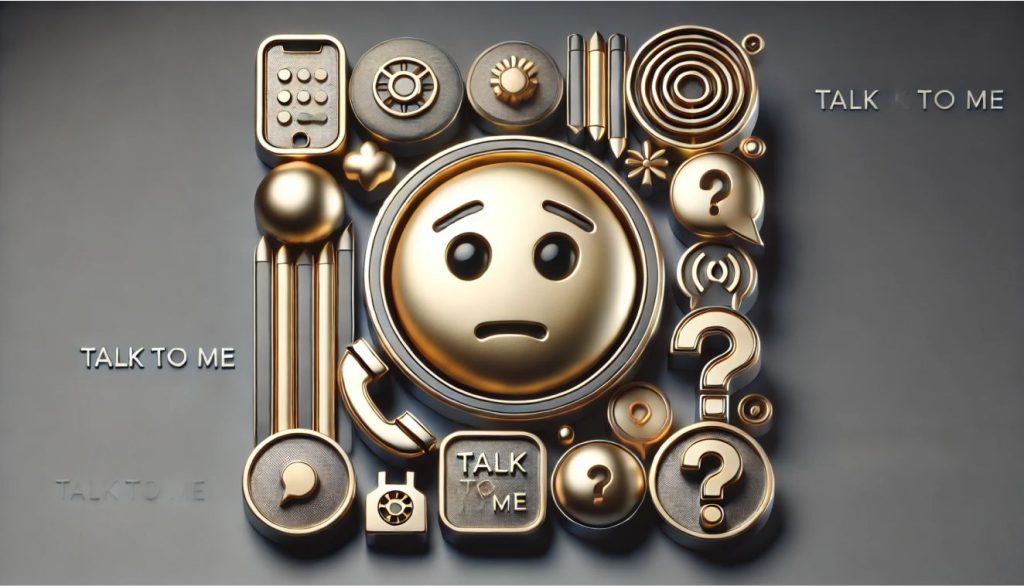Décoder les TTM dans les messages texte
Now, let’s turn our attention to “TTM.” This acronym has gained popularity in text messaging and online communication, but what does it stand for? “TTM” commonly represents the phrase “Talk To Me.” It’s an invitation, a call for conversation, an extension of the digital hand, if you will. When someone uses “TTM” in a message, they’re essentially saying, “I’m here, and I’m ready to chat. Let’s talk.”
What does TTM mean?
Common Variations of “TTM”
While the core meaning remains “Talk To Me,” the context in which it’s used can modify its interpretation. Here are a few common variations and their explanations:
Variation | Signification |
T2M | A shortened form of “Talk To Me.” |
T2U | A request for someone to “Talk To You.” |
T2P | An invitation to “Talk To People” or chat in a group setting. |
TTM2B | Suggests that the individual is available and wants others to initiate conversation with them. |
TTMNA | Implies that someone is eager to talk, but “no one’s around.” |
TTMK | Can be a way of saying “Talk To Me Later.” |
| TTM | Kids sometimes use TTM to mean ‘Talk Too Much’. Ex ‘YOU TTM!’ |
Common Variations of “TTM”
Like many texting abbreviations, “TTM” may have variations and nuances in its usage. While the core meaning remains “Talk To Me,” the context in which it’s used may modify its interpretation. Here are a few common variations and explanations:
T2M: A shortened form of “Talk To Me.”
T2U: A request for someone to “Talk To You.”
T2P: An invitation to “Talk To People” or chat in a group setting.
TTM2B: Suggests that the individual is available and wants others to initiate conversation with them.
TTMNA: Implies that someone is eager to talk, but “no one’s around.”
TTMK: It could be a way of saying “Talk To Me Later.”
TTM: Sometimes used by kids to mean “Talk Too Much.” Example: “YOU TTM!”
The variations showcase the adaptability of “TTM” in various conversation contexts, ranging from one-on-one discussions to group interactions. Additionally, the usage of ‘TTM’ can also vary across other platforms like Instagram and TikTok.
How “TTM” Is Used
Now that we’ve deciphered the meaning of “TTM” let’s explore its practical usage in text messaging. “TTM” is a versatile expression that may be deployed in a variety of situations:
Initiating a Conversation: The most straightforward use of “TTM” is to start a conversation. When you send “TTM” to someone, you’re expressing your readiness to engage in a chat.
Expressing Availability: “TTM” is also used to let others know that you’re available for communication. It’s a way of saying, “I’m here, and I’m open to talking.”
Seeking Engagement: If you’re in a group chat and want to get everyone talking, sending “TTM2B” may be a subtle way of encouraging others to join the conversation.
Indicating a Desire for Communication: “TTMNA” implies that you’re eager to talk but currently don’t have anyone to chat with. It’s a way of expressing your openness to conversation when someone becomes available.
Suggesting a Delayed Conversation: If you’re currently occupied or can’t chat at the moment, you might use “TTMK” to indicate that you’d like to talk later.
Examples of “TTM” in Texting
Let’s break down some examples of how “TTM” lights up our digital conversations.
In many cases, ‘TTM’ can often replace an entire sentence, making communication more efficient.
Personal Conversations
In personal chats, “TTM” adds a friendly, informal touch. It’s like waving someone over to your digital space for a chit-chat. On Instagram, ‘TTM’ is also commonly used in personal chats to foster engagement.
Example: Catching Up with Friends
Text: “Hey! Long time no see, TTM 😊”
Context: Reconnecting with a friend, inviting them to share updates.
Example: Making Plans
Text: “TTM about the weekend plans 📅👍”
Context: Discussing upcoming events or outings with friends.
Professional Context
Even in a professional setting, “TTM” may sneak in, especially in less formal, internal communications. In financial discussions, ‘TTM’ can also stand for ‘Through the Mail,’ referring to documentation or communication methods regarding a company’s past performance.
Example: Work Collaboration
Text: “Got a minute? TTM about the project update. 📈”
Context: Requesting a quick chat about work-related matters.
Example: Scheduling Meetings
Text: “Can you TTM tomorrow for the team meeting? 🗓️”
Context: Arranging or confirming a meeting time.
Romantic or Flirtatious Use
In a more intimate setting, “TTM” becomes a coy invite, sparking private conversations.
Example: Starting a Conversation
Text: “Hey, TTM? I’ve been thinking about you 😏”
Context: Initiating a flirtatious chat with romantic interest.
Example: Deepening Connection
Text: “Miss you, TTM tonight? 🌙💬”
Context: Seeking a more personal, heartfelt conversation.
Interpretations of “TTM”
The beauty of text messaging lies in its flexibility and the potential for multiple interpretations. “TTM” is no exception. Depending on the context and the relationship between the sender and recipient, the meaning of “TTM” may vary. Understanding ‘TTM’ is crucial across various social media platforms like Instagram and TikTok.
Friendly Invitation: In a casual conversation with friends or family, TTM often carries a friendly tone. It’s an open door for discussion, indicating that you’re approachable and eager to chat.
Business or Professional Communication: It could also be used in professional settings to express your availability for work-related discussions. In such cases, it signifies your readiness to engage in a conversation, whether it’s for a business meeting or a work-related project.
Romantic or Flirtatious Use: In a more intimate context, “TTM” may take on a flirtatious undertone. It signals a desire for one-on-one, private communication.
Group Conversations: In group chats, it may serve as a prompt to get everyone talking. It encourages group members to share thoughts and engage in the conversation.
Pop Culture and “TTM”
As texting has become deeply ingrained in our daily lives, it’s no surprise that texting slang, including “TTM,” has found its way into popular culture. You might encounter “TTM” in various forms of entertainment, such as movies, TV shows, and music. In such contexts, it’s used to depict characters engaging in text-based conversations and reflects the modern way people communicate.
For instance, a character in a TV show might dramatically send a “TTM” message to a love interest to convey a longing for connection, adding a layer of intrigue to the storyline. In songs, “TTM” may be incorporated into lyrics, further solidifying its place in contemporary culture.
Beyond explicit uses, “TTM” has permeated social media and internet culture, becoming a symbol of digital connection in the 21st century. For more information on texting abbreviations and their meanings, you can visit our dedicated page.
Personal Examples of Using “TTM” with Emojis
Texting is an art, and when you blend the succinct charm of “TTM” with the expressive power of emojis, you create digital masterpieces of conversation. Check out the following examples below:
Chat amical: “TTM, what’s up? 😄” — Uses the Smiling Face Emoji to initiate a light-hearted conversation.
Seeking Advice: “Can you TTM? Need some advice 🤔” — Uses the Thinking Emoji to ask for guidance or suggestions.
Group Interaction: “Everyone, TTM in the group chat! 🗣️👥” — Uses the Speaking Head and People Emojis to encourage group discussion.
After a Date: “Had a great time! TTM again soon? 💑” — Uses the Couple with Heart Emoji to express interest in further communication post-date.
Work Follow-Up: “About the client feedback, TTM pls 📊” — Uses the Bar Chart Emoji to discuss professional matters.
Réconforter un ami: “TTM if you need to talk, I’m here 🤗” — Uses the Hugging Face Emoji to offer support during tough times.
Sharing Excitement: “TTM about the concert details! 🎶🎉” — Uses the Musical Notes and Party Popper Emojis to discuss an exciting event or plan.
When Not to Use the TTM Acronym
There are certain situations where TTM may not be appropriate. Here are guidelines to keep in mind:
1. Formal Settings: TTM is generally considered informal and casual. Avoid using it in professional or formal settings, such as business emails or official communications.
2. Serious Conversations: If you’re discussing a sensitive or serious topic, it’s best to avoid using TTM. Stick to using full words and phrases to convey your message clearly and respectfully.
3. Older Generations: While TTM is widely used among younger generations, it may not be familiar to older individuals. If you’re communicating with someone who is not as tech-savvy, it’s best to avoid using abbreviations that they may not understand.
4. International Communication: When texting with someone from a different culture or country, it’s important to be mindful of language barriers and cultural differences. TTM may not be universally understood, so it’s best to avoid using it in international communication unless you’re sure the other person is familiar with texting abbreviations.
5. Sensitive Topics: If you’re discussing a sensitive or serious topic, it’s best to avoid using TTM. Stick to using full words and phrases to guarantee your message is understood and taken seriously.
Personal Examples of Using “TTM” with Emojis
Wrapping up, texting is an art, and when you blend the succinct charm of “TTM” with the expressive power of emojis, you create digital masterpieces of conversation. This section showcases how “TTM” can be weaved into various texting scenarios, each enhanced with emojis to convey emotions and intentions more vividly. From catching up with friends to professional check-ins, see how “TTM” takes on different tones and meanings in the world of texting.
| Scénario | Exemple de texte | Emojis utilisés | Contexte |
|---|---|---|---|
| Chat amical | “TTM, what’s up? 😄” | Emoji visage souriant | Initiating a light-hearted conversation |
| Seeking Advice | “Can you TTM? Need some advice 🤔” | Emoji de la pensée | Asking for guidance or suggestions |
| Group Interaction | “Everyone, TTM in the group chat! 🗣️👥” | Speaking Head and People Emoji | Encouraging group discussion |
| After a Date | “Had a great time! TTM again soon? 💑” | Couple with Heart Emoji | Expressing interest in further communication post-date |
| Work Follow-Up | “About the client feedback, TTM pls 📊” | Bar Chart Emoji | Discussing professional matters |
| Réconforter un ami | “TTM if you need to talk, I’m here 🤗” | Hugging Face Emoji | Offering support during tough times |
| Sharing Excitement | “TTM about the concert details! 🎶🎉” | Musical Notes and Party Popper Emoji | Discussing an exciting event or plan |
And there you have it, folks! A vivid tableau of how “TTM,” blended with the perfect emojis, can add zest and clarity to your texts. Whether it’s a smile, a thoughtful gesture, or a burst of excitement, the right emoji can turn a simple “Talk To Me” into a conversation starter.
Questions fréquemment posées et réponses
In texting, “TTM” stands for “Talk To Me.” It’s used as an invitation for conversation, signaling that the sender is open and ready to chat.
“TTM” is commonly used to initiate a conversation, express availability for chatting, or as a friendly nudge to encourage someone to communicate.
When a boy texts “TTM,” it typically means he’s inviting a conversation or showing interest in communicating. It can be friendly, flirtatious, or simply a way to start a dialogue.
If a girl sends “TTM,” it usually indicates her desire to engage in a conversation. It might suggest friendliness, openness to chat, or interest in the person she’s texting.
Variations like “T2M,” “T2U,” “T2P,” “TTM2B,” “TTMNA,” and “TTMK” exist, each carrying slightly different meanings but centered around the theme of communication.








